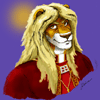
As mentioned in the other parts of this series, this Paw Study is part of the Balaa’s “Artist Conspiracy” series, who’s whole purpose is to provide both good reference pictures for artists as well as inspiration to try them out in new artwork! There are nine pictures in this series, with the “number zero” having been posted a long, long time ago now: http://www.furaffinity.net/view/432365/
As this /is/ a Paw Study, I thought the very best candidate for modeling would best be a kitty with very large and imposing paws, who doesn’t mind showing them off. So, logically, that led me to The DrifterMan, who was more than happy to volunteer.
Overall, this is a very horrible picture that I wouldn’t normally proudly display on my bathroom wall. However, this picture does serve quite a useful function in terms of a Paw Study, even though it’s a bit blurry.
While I would never wish to come across as being horribly criticizing of artists, I have found in many anthro and non-anthro artworks, many artists have trouble drawing paws. I do not, of course, fault them for the valiant attempt, but rather for the lack of accurate reference material. It is my hope that this picture will be exactly that: accurate reference. So having spoken my disclaimer...
Felines, and many other animal species, actually walk on the toes, hence the term “digitigrade” - standing on the digits - versus the way humans walk, along the entire underside of the foot, or “plantigrade”. I think this picture clearly displays the concept of digitigrade, especially in the feline form. So blurry as it is, this picture shows off the basic structural form that the paw takes on when the feline is standing. The camera angle is somewhat awkward, besides the chain-link being in the way, so it is a little difficult to see exactly how the bone structure bends. Nonetheless, I chose this picture for display in the hopes that a poor reference picture is better than no reference picture.
Another small piece of paw trivia can be seen on the left forepaw. While somewhat difficult to see because of the angles, the dark line of fur, which hides the dewclaw, is slightly visible in this picture. I mentioned this specifically for the sake of offering a frame of reference as to where the dewclaw is in the overall structure of the paw, most notably while the feline is standing.
So this is the sixth image of the Drifter Paw Study. Enjoy!
This picture was taken 01-Jan-04. The image was taken with a Canon EOS 10D and the EF 28-200mm f/3.5-5.6 USM lens. The original was taken at full frame of 3072x2048x24b, ISO eqv 400, 1/350 shutter, f/5.6. This image was shrunken down for space conservation.
As this /is/ a Paw Study, I thought the very best candidate for modeling would best be a kitty with very large and imposing paws, who doesn’t mind showing them off. So, logically, that led me to The DrifterMan, who was more than happy to volunteer.
Overall, this is a very horrible picture that I wouldn’t normally proudly display on my bathroom wall. However, this picture does serve quite a useful function in terms of a Paw Study, even though it’s a bit blurry.
While I would never wish to come across as being horribly criticizing of artists, I have found in many anthro and non-anthro artworks, many artists have trouble drawing paws. I do not, of course, fault them for the valiant attempt, but rather for the lack of accurate reference material. It is my hope that this picture will be exactly that: accurate reference. So having spoken my disclaimer...
Felines, and many other animal species, actually walk on the toes, hence the term “digitigrade” - standing on the digits - versus the way humans walk, along the entire underside of the foot, or “plantigrade”. I think this picture clearly displays the concept of digitigrade, especially in the feline form. So blurry as it is, this picture shows off the basic structural form that the paw takes on when the feline is standing. The camera angle is somewhat awkward, besides the chain-link being in the way, so it is a little difficult to see exactly how the bone structure bends. Nonetheless, I chose this picture for display in the hopes that a poor reference picture is better than no reference picture.
Another small piece of paw trivia can be seen on the left forepaw. While somewhat difficult to see because of the angles, the dark line of fur, which hides the dewclaw, is slightly visible in this picture. I mentioned this specifically for the sake of offering a frame of reference as to where the dewclaw is in the overall structure of the paw, most notably while the feline is standing.
So this is the sixth image of the Drifter Paw Study. Enjoy!
This picture was taken 01-Jan-04. The image was taken with a Canon EOS 10D and the EF 28-200mm f/3.5-5.6 USM lens. The original was taken at full frame of 3072x2048x24b, ISO eqv 400, 1/350 shutter, f/5.6. This image was shrunken down for space conservation.
Category Photography / Animal related (non-anthro)
Species Housecat
Size 1280 x 854px
File Size 120.7 kB
(belatedly) If you look close, you can kinda see where the dewclaw is. Technically, where you see the paw "bent" at the almost 90-deg angle there, that would be analogous to our knuckles. So from the purely biological perspective, the dewclaw comes out in the same, equivalent position as our thumb would be positioned, which would effectively be below the wrist, and adjacent to the palm. :) Again, kinda hard to see in this shot.
Thanks very much, ShastaCat. Most every big cat fanciers take the "standard" pictures of our furry friends. Face, yawning, whatever. But no one thinks of the little things like the paw "feet" themselves. This pic really conveys "digitigrade". Many thanks to you and Drifter.
(belatedly) I'm glad you like the series. I know there are a lot of artist out there, and I like being able to give them more ammunition to use as a basis for their own works. I know there's a lot of different styles and interests out there, but being an engineer and biologist, I tend to like the "accuracy" thing, so... In any case, I'm glad you enjoyed Drifter's contributions. :)
There's not a lot of help out on the web on this, either. Here's a post that might also help (if you ignore the last para on the first post (ouch)):
http://answers.google.com/answers/t.....id/449818.html
A lot of the references require registration but this image was easily viewable
http://fp.dl.kent.edu/hyork/catfeet.htm
http://answers.google.com/answers/t.....id/449818.html
A lot of the references require registration but this image was easily viewable
http://fp.dl.kent.edu/hyork/catfeet.htm

 FA+
FA+











Comments